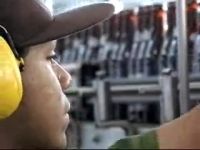
Few things can compare to a cold beer after a hard day’s work.
But when you grab that cold beer or stout – have you ever stopped to think
where it came from, who made it, and what’s in it? Well we did and that’s
why tonight “7 On The Inside” is going to take you inside the Belize
Brewing Company in Ladyville. That’s where the Bowen family began brewing
Belikin Beer in 1971. Since then the operation has expanded and today in a $50
million state of the art factory – the company brews and bottles Belikin
Beer, Belikin Stout, Premium Beer and Guinness Stout. Keith Swift has the story
from the inside.
Keith Swift Reporting,
You wouldn’t know it by looking at them, but these aromatic green capsules
are the most important ingredient in a bottle of beer. They are compressed pellets 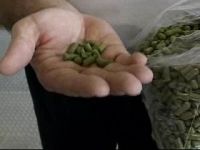 of the flowering plant known as hops.
of the flowering plant known as hops.
Enrique Szekely, Brew Master
“Hops play a very important role in the taste of the beer and in the
aroma of the beer. The more hops you have, the more bitterness you have in the
beer. The less hops you have, the less bitterness you have in a beer.
The grains they come from Canada and this is one of the main ingredients.
Of course it is like we told you earlier it is hops, it is malt, water, and
yeast. And this makes, the grains of malt, once we mix this grain with water
after having crushed them or milled them, we will obtain a very sweet liquid.”
Brewing of the beer starts in these large vessels where the hops, Canadian
malt, yeast and water are slowly churned and cooked for 90 minutes.
Keith Swift,
So it is the water, the malt, the hops, and it is mixed together.
Enrique Szekely,
“Every part of it has a process. So first you will mill the malt,
you will mix it with water, then you will separate the solids from the liquid  and then you boil it, add the hops, cool it down, and then inject the yeast
to the cold water.”
and then you boil it, add the hops, cool it down, and then inject the yeast
to the cold water.”
The entire process is completely managed and monitored by a computer system
which tells this operator what’s happening in every part of the plant.
It controls an intricate and complex process with it seems an infinite number
of gauges, valves and joints. And to keep it all in check, they used to require
25 employees; now they just need one person to monitor it.
Carlos Turcios, Assistant Brew Master
“One operator controls the entire processing area which is the brew
house, fermentation, storaging and filtration and we have rotation of shifts
every eight hours.”
Keith Swift,
He and she just sits there and they can just see the entire process, they can
just monitor it from that?
Carlos Turcios,
“Yes that is right because all the recipes are in the database. Any
fault, we have an emergency and it will be indicated. It will tell you exactly
where it is, what caused the problem, and what is causing the delay. So it is 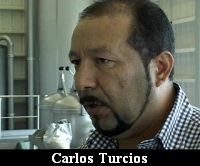 easy.”
easy.”
The brew is fermented for 7 days in these giant tanks located in the cellar.
There are 18 of them - – each capable of storing brew amounting to 10,000
cases of beer. Fermentation is followed by storage for an additional 14 days.
Carlos Turcios,
“After fermentation has been completed we put on the cooling on the
vessels where we will have the yeast settle at the bottom, remove the yeast,
select the yeast that we are going to use for a next cycle and go into storage
for a minimum of fourteen days.”
Keith Swift,
So from the moment you put the yeast, the malt, and the hops together how long
is it before that beer is ready for the market?
Carlos Turcios,
“Like I told in total a minimum of 21 days which is 7 days fermenting,
14 days in storage and we go from there to bottling."
But before bottling – the brew is put through a thorough filtration process
– also in the cellar. It too is electronically controlled to remove any
remaining sediments from the brew – which as you can see in this exposed
pipe is still turbid. Today they were filtering beer, but bottling stout –
and that’s the dark lustrous liquid in the pipe.
From here, the vast network of pipes transport the beer next door to the bottling
plant – the most labour intensive stage of production. Today they were
bottling stout. The plant is capable of filling 425 bottles per minute.
Dwayne Murillo is on the frontline of bottling as everyday – or every
minute as the case may be - he loads crates of empties onto the conveyor belt. 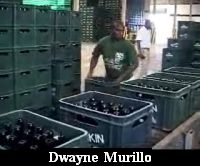 His job may be the hardest one at the plant – and I know because I tried
it. It was hard for me but easy for Murillo.
His job may be the hardest one at the plant – and I know because I tried
it. It was hard for me but easy for Murillo.
Dwayne Murillo, Employee
“My job is to help load the pallets and just take it off and so.”
Keith Swift,
How many crates do you move a day?
Dwayne Murillo,
“Sometime fourteen, sometime fifteen pallets. This is not hard, it
is not hard. If you put your mind against it will be hard for you.”
From Murillo the bottles travel along the conveyor belt where napkins and lots
of straws are removed. It then undergoes a thorough cleaning process where mud
and other dirt are scrubbed out in a massive washer. The pints go in dirty and
they come out clean. Workers then manually check the bottles for any remaining
dirt and then they are filled – again 425 bottles per minute. They are
rapidly sealed, washed again, and then heated to 158 degrees – a process 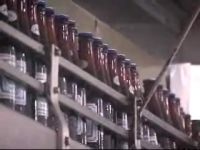 called pasteurization. That is to kill all remaining bacteria which prolongs
its shelf life to six months.
called pasteurization. That is to kill all remaining bacteria which prolongs
its shelf life to six months.
They are then corralled into groups of 72 and put into crates for delivery
to a store or a bar near you. But before it reaches the stores – the beer
and stout has to pass through the lab. Daniel Vasquez checks for bacteria.
Daniel Vasquez, Micro-Biology Lab Technician
“What we do right here is check that the product is clean of beer
spoiling bacteria and if there is any bacteria that could damage the beer, there
are measures taken and so it is very important.”
Next door Claro Blanco probably has a dream job – every day she along  with a panel of experts judge beer and stouts for consistency, aroma, and flavour.
with a panel of experts judge beer and stouts for consistency, aroma, and flavour.
Claro Blanco, Laboratory Technician
“We do a routine analysis for all the bottling that takes place everyday.
Here we have the set up of a tasting panel which is carried out on a routine
basis everyday. We do taste testing with the brew master, the assistant, and
a weekly tasting panel with Mr. Kevin Bowen. Actually everyday when there is
bottling, we do analysis three times. We do this routine that we have the list,
we do it three times to make sure that everything is under control and that
everything is good quality. Lots of people envy me because I work at the brewery
and they would want to taste a beer everyday and we have the luxury of doing
that but professionally.”
And since I was there – I did a taste test of my own. The Brewery’s
General Manager Kevin Bowen says their state of the art factory and quality
assurance are all part of a world class operations.
Kevin Bowen, General Manager
“I am pretty proud that we have a bloody good company that everyone  should be proud of as a Belizean.”
should be proud of as a Belizean.”
Brewery Engineer,
“I think you had a chance to go around the brewery and the brew house
is actually very comparable to technology in Western Europe where a lot of the
work we do actually started.”
Kevin Bowen,
“Our product, what separates it from other products in this Western
Hemisphere is the high percentage of malt that we use. The other products from
our big neighbour to the north Mexico use a very low percentage of malt and
they use the balance of rice. In Germany, they use 100% malt because of their
purity law. We’re very close to that. No one else can say that in this
part of the Western Hemisphere.”
Keith Swift,
And the difference that makes is?
Kevin Bowen,
“The taste; it doesn’t taste like water, it tastes like beer.”
Carlos Turcios,
“People think making beer is like making kool-aid with sugar and water
and it is not so. You come here and you see the cleanliness, the raw materials
we use – it is so amazing and I have been to different breweries in the
world and I was shocked when this brewery was put up because I’d been
working with the old brewery where I contributed a lot with the hard labour
work and coming here, it is so easy. My days go easy without a sweat.”
So the next time you drink a beer – think of the work that went into
it: it is definitely both an art and a strictly controlled science.
8,000 cases of beer are bottled a day. Belize Brewing Company has 95
employees. That is 30 less than it had before the new factory was built. A new
bottling facility should be installed in two years and that too should be fully
automated.



